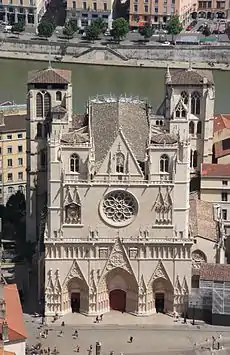Lyon Cathedral
Lyon Cathedral (French: Cathédrale Saint-Jean-Baptiste de Lyon) is a Roman Catholic church located on Place Saint-Jean in Lyon, France. The cathedral is dedicated to Saint John the Baptist, and is the seat of the Archbishop of Lyon.
| Lyon Cathedral Cathédrale Saint-Jean-Baptiste de Lyon | |
|---|---|
 Lyon Cathedral. | |
| Religion | |
| Affiliation | Roman Catholic Church |
| Province | Archdiocese of Lyon |
| Region | Rhône-Alpes |
| Ecclesiastical or organizational status | Cathedral |
| Status | Active |
| Location | |
| Location | Lyon, |
| Geographic coordinates | 45°45′38″N 4°49′39″E |
| Architecture | |
| Type | church |
| Style | Gothic |
| Groundbreaking | 1180 |
| Completed | 1480 |
History
The cathedral was founded by Saint Pothinus and Saint Irenaeus, the first two bishops of Lyon. The cathedral is also known as a "Primatiale" because in 1079 the Pope granted to the archbishop of Lyon the title of Primate of All the Gauls with the legal supremacy over the principal archbishops of the kingdom. It is located in the heart of the old town (Vieux Lyon) and it backs up to the Saône river, with a large plaza in front of it and a metro stop nearby providing easy access to and from the city center.[1]
Patiens of Lyon, who was bishop about 450, built a new cathedral, dedicated to Saint Stephen. Later, in the seventh century, a baptistery dedicated to Saint John was constructed as an accessory building to the church. The Church of St. Croix was also near. This location later became the site of the Cathédrale Saint-Jean-Baptiste.[2]
In 1245, the cathedral hosted the First Council of Lyon.[3]
In 1819 J. M. W. Turner sketched a study of the Cathedral as seen from the heights of the Fourvière Hill.[4] Edgar Degas used the cathedral for the setting of his painting "Ceremony of Ordination at Lyon Cathedral".
Festival of Light
Each December, Lyon holds an annual Festival of Lights. The tradition dates to 1643, when on December 8, the people of Lyon would place a lit candle in the window, a custom still maintained by many residents to this day. During the Festival, a choreographed lighting display appears on the façade of the cathedral.
Description
Begun in 1180 on the ruins of a 6th-century church, it was completed in 1476. The building is 80 meters long (internally), 20 meters wide at the choir, and 32.5 meters high in the nave. The apse and choir are of Romanesque design; the nave and façade are Gothic.
Noteworthy are the two crosses to right and left of the altar, preserved since the Second Council of Lyon of 1274 as a symbol of the union of the churches, and the Bourbon chapel, built by the Cardinal Charles II, Duke of Bourbon and his brother Pierre de Bourbon, son-in-law of Louis XI, a masterpiece of 15th century sculpture.
The cathedral also has the Lyon Astronomical Clock from the 14th century.
The cathedral organ was built by Daublaine and Callinet and was installed in 1841 at the end of the apse and had 15 stops. It was rebuilt in 1875 by Merklin-Schütze and given 30 stops, three keyboards of 54 notes and pedals for 27.
Until the construction of the Basilica of Notre-Dame de Fourvière, it was the pre-eminent church in Lyon.
Organists in residence
- Edouard Commette - most of the first half of the 20th century.
Burials
Gallery
 The front elevation of the Cathedral
The front elevation of the Cathedral Interior of the Cathedral
Interior of the Cathedral.JPG.webp) front elevation of the Cathedral by night during Festival of Lights (Lyon)
front elevation of the Cathedral by night during Festival of Lights (Lyon) Exterior, overlooked by the Basilica of Notre-Dame de Fourvière
Exterior, overlooked by the Basilica of Notre-Dame de Fourvière
Sources
- Association Cathédrale de Lyon Primatiale Saint John n.d.
See also
References
- Transportation for the Community of Lyon. "My Journey".
- "Penny Magazine of the Society for the Diffusion of Useful Knowledge", Vol. 9, G. Knight & Company, 1840, p. 546
- Christopher M. Bellitto, The General Councils:A History of the Twenty-One Church Councils from Nicaea to Vatican II, (Paulist Press, 2002), 57.
- "Cathedral of Saint Jean-Baptiste, Lyon, from the Fourvière Hill", Tate
| Wikimedia Commons has media related to Lyon Cathedral. |